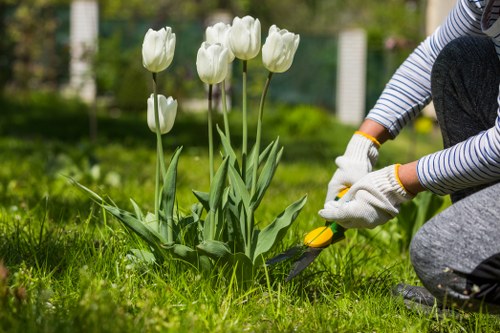Lawn Mower Coney Hall: Your Ultimate Guide to a Perfect Lawn

Maintaining a pristine lawn is a source of pride for many homeowners in Coney Hall. A well-mowed lawn not only enhances the aesthetic appeal of your property but also contributes to the overall health of your outdoor space. Whether you’re a seasoned gardener or a novice, understanding the essentials of lawn mowing can make a significant difference.
In this comprehensive guide, we delve into everything you need to know about lawn mowing in Coney Hall. From selecting the right mower to mastering the best mowing techniques, we cover all aspects to help you achieve a lush, green lawn.
Let’s explore the best practices, tips, and local insights to ensure your lawn remains the envy of the neighborhood.
Choosing the Right Lawn Mower

Selecting the appropriate lawn mower is the first step towards achieving a healthy lawn. In Coney Hall, the climate and grass types play a crucial role in determining the best mower for your needs.
There are several types of mowers available, each with its unique advantages:
- Manual Push Mowers: Ideal for small yards, they are eco-friendly and require no fuel.
- Electric Mowers: Quiet and low-maintenance, suitable for medium-sized lawns.
- Gas-Powered Mowers: Offer more power and are suitable for large lawns with tough grass.
- Robotic Mowers: Convenient and automated, perfect for those who prefer a hands-off approach.
Consider factors such as lawn size, terrain, and your physical ability when making a choice.
Features to Look For

When selecting a lawn mower, several features can enhance your mowing experience:
- Adjustable Cutting Heights: Allows you to customize the length of your grass.
- Mulching Capability: Helps recycle grass clippings, enriching the soil.
- Self-Propelled: Reduces the effort required, especially on uneven terrain.
- Grass Collection Bag: Convenient for collecting clippings without a messy finish.
These features can make mowing more efficient and tailored to your garden’s specific needs.
Best Mowing Practices

Proper mowing techniques are essential for maintaining a healthy lawn. Here are some best practices to follow:
- Mow Regularly: Depending on the grass type and growth rate, mow your lawn once a week during the growing season.
- Maintain Sharp Blades: Dull blades can damage grass, leading to a ragged look and increased vulnerability to pests.
- Don’t Cut Too Short: Leaving grass a bit longer promotes deeper roots and better drought resistance.
- Mow in Different Directions: Changing the mowing pattern prevents grass from leaning in one direction and ensures even growth.
Implementing these practices will contribute to a greener, healthier lawn.
Seasonal Lawn Care Tips

Different seasons require different lawn care strategies. Here’s how to adjust your mowing routine throughout the year:
- Spring: As the grass begins to grow, mow regularly and fertilize to support new growth.
- Summer: Mow higher to provide shade to the roots, helping the lawn retain moisture.
- Fall: Continue regular mowing and prepare the lawn for the winter months with proper fertilization.
- Winter: Reduce mowing frequency as grass growth slows, and clear away any debris to protect the lawn.
Adapting your mowing schedule to the seasons ensures your lawn remains resilient and vibrant year-round.
Local Insights: Lawn Mowing in Coney Hall

Coney Hall offers a unique environment for lawn care, with its specific climate and soil conditions. Understanding the local factors can help you tailor your lawn mowing practices effectively.
The area typically experiences mild winters and warm summers, which influences the growth patterns of local grass types. It’s essential to choose grass varieties that thrive in these conditions and require minimal maintenance.
Additionally, local regulations may impact mowing schedules and practices, so it’s advisable to stay informed about community guidelines.
Top Grass Types for Coney Hall Lawns

Choosing the right grass type is crucial for a lawn that endures Coney Hall’s climate. Here are some popular options:
- Fescue: Known for its durability and adaptability to different soil types.
- Bermuda Grass: Ideal for sunny areas, it is heat-tolerant and recovers quickly from wear.
- Kentucky Bluegrass: Offers a lush, green appearance and withstands foot traffic well.
- Ryegrass: Fast-growing and great for overseeding to maintain a green lawn throughout the year.
Selecting the appropriate grass type will reduce maintenance efforts and enhance the lawn’s natural beauty.
Maintaining Lawn Equipment

Proper maintenance of your lawn mower is essential to ensure its longevity and performance. Here are some maintenance tips:
- Clean After Each Use: Remove grass clippings and dirt to prevent rust and build-up.
- Regularly Sharpen Blades: Sharp blades make cleaner cuts and promote healthier grass growth.
- Inspect for Wear and Tear: Check belts, filters, and other components regularly to address any issues promptly.
- Store Properly: Keep your mower in a dry, sheltered area to protect it from the elements.
Routine maintenance can prevent costly repairs and ensure your mower operates efficiently.
Safety Tips for Lawn Mowing

Safety should always be a priority when mowing the lawn. Follow these tips to prevent accidents and injuries:
- Wear Protective Gear: Safety glasses, gloves, and sturdy footwear can protect you from debris and accidents.
- Clear the Area: Remove toys, sticks, stones, and other objects that could be thrown by the mower.
- Check for Obstacles: Ensure there are no hidden objects or uneven terrain that could cause the mower to trip.
- Follow Manufacturer’s Instructions: Adhere to the guidelines provided in your mower’s manual for safe operation.
Implementing these safety measures ensures a risk-free mowing experience.
Eco-Friendly Mowing Practices

Adopting eco-friendly mowing practices can benefit both your lawn and the environment. Here are some sustainable tips:
- Mow During Cooler Hours: Mowing in the early morning or late evening reduces water loss and stress on the grass.
- Leave Grass Clippings: Mulching clippings can return valuable nutrients to the soil, reducing the need for fertilizers.
- Use Electric or Manual Mowers: These options produce fewer emissions compared to gas-powered mowers.
- Water Efficiently: Water your lawn deeply but infrequently to encourage deep root growth and reduce water waste.
These practices contribute to a healthier lawn and a greener planet.
Composting Grass Clippings

Composting grass clippings is an excellent way to recycle yard waste and create rich compost for your garden. Here’s how to get started:
- Collect Clippings: Gather grass clippings from your mower and let them dry slightly to prevent matting.
- Create a Compost Pile: Alternate layers of green clippings with brown materials like leaves or straw.
- Maintain Moisture: Keep the pile damp but not soggy to encourage decomposition.
- Turn Regularly: Aerate the pile by turning it every few weeks to speed up the composting process.
Using composted clippings enriches your soil, promoting healthier plant growth.
Local Services and Resources

If you prefer professional assistance, Coney Hall boasts a range of local lawn care services. These experts offer tailored solutions to meet your specific lawn needs, from regular mowing to specialized treatments.
Engaging with local professionals ensures you receive personalized care and support, leveraging their knowledge of the area’s climate and soil conditions.
Additionally, local garden centers and nurseries provide valuable resources and products to maintain and enhance your lawn’s health.
Hiring a Lawn Care Service

When considering hiring a lawn care service in Coney Hall, keep the following tips in mind:
- Check Credentials: Ensure the service has the necessary licenses and insurance.
- Read Reviews: Look for testimonials and feedback from other local customers.
- Compare Prices: Obtain quotes from multiple providers to find the best value.
- Ask About Services: Confirm that the service offers the specific lawn care tasks you need.
Choosing a reputable service can save you time and ensure your lawn receives expert care.
Maintaining a Healthy Lawn

A healthy lawn requires more than just regular mowing. Proper fertilization, watering, and pest control are all essential components of lawn maintenance.
Implementing a holistic approach ensures your grass remains vibrant and resilient against common challenges.
Let’s explore some key aspects of maintaining a lush lawn:
Fertilization and Soil Health

Fertilizing your lawn provides the necessary nutrients for growth. Here are some tips:
- Choose the Right Fertilizer: Select a product that matches your grass type and soil needs.
- Apply at the Right Time: Typically, fertilize in the spring and fall when grass is actively growing.
- Follow Application Guidelines: Over-fertilizing can harm your lawn and the environment.
- Test Your Soil: A soil test can help determine nutrient deficiencies and pH levels.
Maintaining soil health is fundamental to a thriving lawn.
Watering Strategies

Proper watering is critical for lawn health. Here are effective strategies to ensure your lawn gets the right amount of water:
- Water Deeply: Encourage deep root growth by providing ample water in one go rather than frequent shallow watering.
- Water Early: Early morning watering reduces evaporation and allows grass blades to dry before nightfall, minimizing disease risk.
- Use Efficient Irrigation Systems: Drip irrigation or sprinkler systems with timers can optimize water usage.
- Monitor Weather Conditions: Adjust your watering schedule based on rainfall and temperature changes.
Effective watering practices conserve water and promote a resilient lawn.
Pest and Weed Control

Protecting your lawn from pests and weeds is essential for maintaining its beauty and health. Here are some control methods:
- Identify Common Pests: Recognize signs of pests like grubs, ants, and beetles to address them promptly.
- Use Safe Pesticides: Choose environmentally friendly options to minimize harm to beneficial insects.
- Implement Weed Prevention: Regular mowing and proper fertilization can reduce weed growth.
- Remove Weeds Manually: Hand-pulling can be effective for small infestations.
Maintaining vigilance against pests and weeds ensures a healthy and attractive lawn.
10-15 Closest Areas to Coney Hall

Coney Hall is surrounded by several vibrant communities, each offering unique features that complement your lawn care needs. Here are the closest areas to consider:
- Dorking: Renowned for its picturesque gardens and local gardening clubs.
- Leatherhead: Offers a variety of lawn care services and nurseries.
- East Clandon: Known for its spacious lawns and community parks.
- West Clandon: Features beautifully maintained public gardens.
- Cheam Home to several reputable landscaping companies.
- Byfleet: Offers access to a range of gardening resources and tools.
- Oxshott: Boasts extensive green spaces and high-quality lawns.
- Weybridge: Known for its lush gardens and professional lawn services.
- Staines: Provides numerous options for lawn maintenance and care.
- Littleton: Offers a close-knit community with shared gardening tips.
- Addlestone: Features several local nurseries and garden centers.
- Chertsey: Known for its expansive lawns and green initiatives.
- Newchapel: Offers tailored lawn care solutions for diverse needs.
- Fairmile: Home to expert lawn care professionals and enthusiasts.
- Guildford: Provides a wide range of landscaping services and products.
Each of these areas complements Coney Hall’s lawn care scene, offering additional resources and services to help you maintain a beautiful lawn.
Conclusion

Achieving and maintaining a beautiful lawn in Coney Hall is a rewarding endeavor that combines the right tools, techniques, and local knowledge. By selecting the appropriate lawn mower, adhering to best mowing practices, and leveraging local resources, you can ensure your lawn remains healthy and vibrant throughout the year.
Remember, a well-maintained lawn not only enhances your property’s curb appeal but also provides a serene and enjoyable outdoor space for relaxation and recreation.
Embrace these tips and enjoy the lush greenery of your Coney Hall lawn.
Frequently Asked Questions

1. How often should I mow my lawn in Coney Hall?
Typically, mowing once a week during the growing season is sufficient. However, the frequency may vary based on grass growth rate and weather conditions.
2. What is the best time of day to mow the lawn?
The best time to mow is in the early morning or late evening when temperatures are cooler, reducing stress on the grass.
3. How high should I set my mower for optimal grass health?
Setting your mower to cut grass at around 2.5 to 3 inches promotes deep root growth and helps the lawn retain moisture.
4. Can I leave grass clippings on the lawn?
Yes, leaving grass clippings can act as natural fertilizer, returning nutrients to the soil. However, ensure they are not too thick to prevent matting.
5. When is the best time to fertilize my lawn?
The optimal times to fertilize are during the spring and fall when grasses are actively growing and can effectively absorb nutrients.